https://www.valigiablu.it/crisi-climatica-distruzione-diga-ucraina/
- |
The weekly round-up on the climate crisis and data on carbon dioxide levels in the atmosphere.
It seemed like a quiet night near the Kakhovka hydroelectric power plant in Ukraine.Then suddenly a roar and the sound of flowing water.“We are now used to loud bangs and so I didn't think it was anything serious,” he said an inhabitant of the southern shore town of Nova Kakhovka.Within minutes water began flowing through a breach.And soon the passage crossing the Dnipro River was washed away.The dam built by the USSR in 1956, an important source of water for the Crimean peninsula annexed by Russia, for the region's agriculture and for cooling the reactors of the Zaporizhzhia nuclear power plant, no longer existed while a massive wave of water began to flow downstream, causing a social, economic and ecological catastrophe.
A torrent of water burst through a gaping hole in a dam on the Dnipro River that separates Russian and Ukrainian forces in southern Ukraine, flooding a swamp of the war zone and forcing villagers to flee https://t.co/0oMMp8IlSH pic.twitter.com/Suj8eKYl3k
— Reuters (@Reuters) June 6, 2023
“The biggest man-made catastrophe in Europe in recent decades,” commented Ukrainian President Volodymyr Zelensky, bringing to mind the memory of the Chornobyl nuclear disaster in 1986.“An act of ecocide with vast and decades-long consequences”, he added as they began to look for causes and responsibilities, to count the damage, to try to save the inhabitants of the region, around 16 thousand, already severely tested by the war and surprised by the floods.
What happened
At 2.50 am on June 6, an explosion destroyed the Kakhovka dam, Ukrainian President Zelensky said.The 3.3 kilometer-long dam, the second largest on the Dnipro, is located along the front line in southern Ukraine and, together with its hydroelectric power plant, was captured by Russian forces at the start of the large-scale invasion , on February 24, 2022.
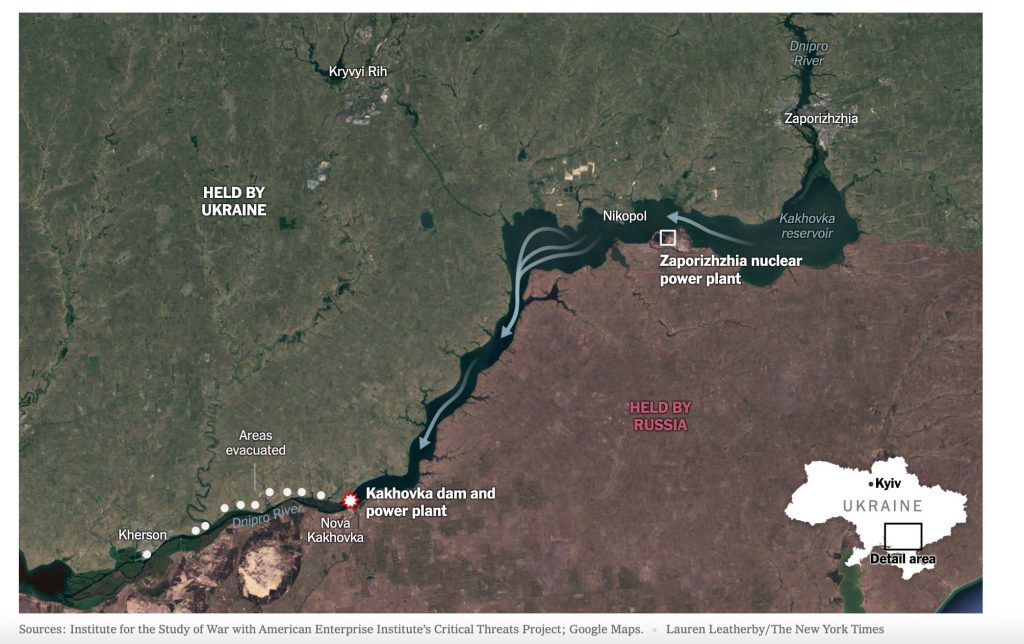
Satellite images before and after the destruction of the dam provide an even clearer picture of the extent of the damage.
First satellite images of the destroyed #Kakhovka Hydroelectric Power Plant
— KyivPost (@KyivPost) June 6, 2023
Its building is completely destroyed.
📷: @cxemu pic.twitter.com/G9nPmH8YP1
Floods in the territories downstream of the Kakhovka dam they took away everything that came across his path:houses, gardens, trees, vegetable patches, cars, sheds, domestic and wild animals.
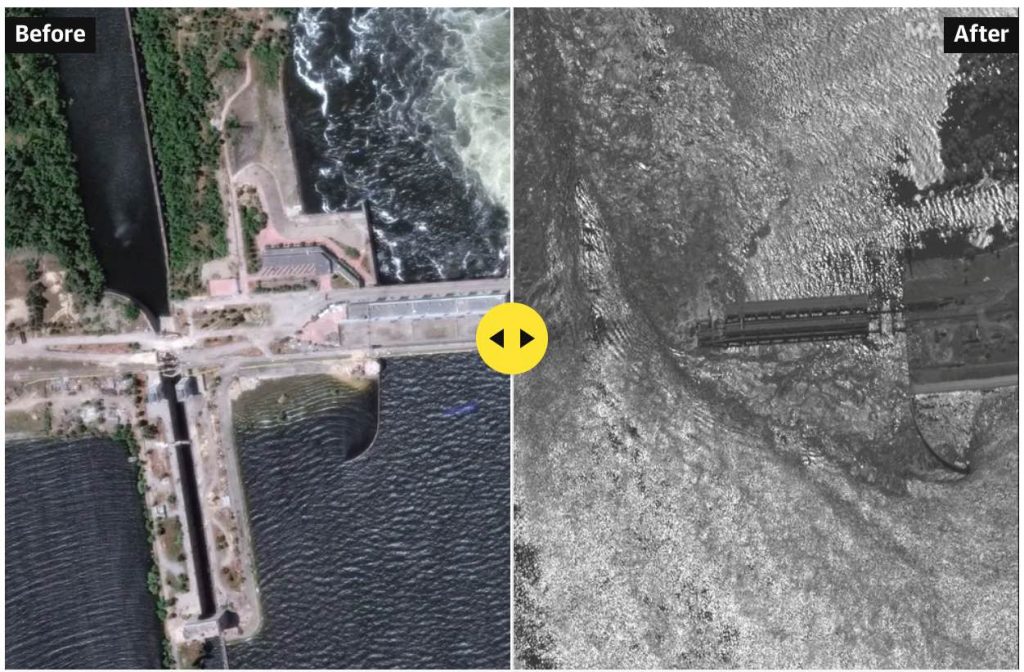
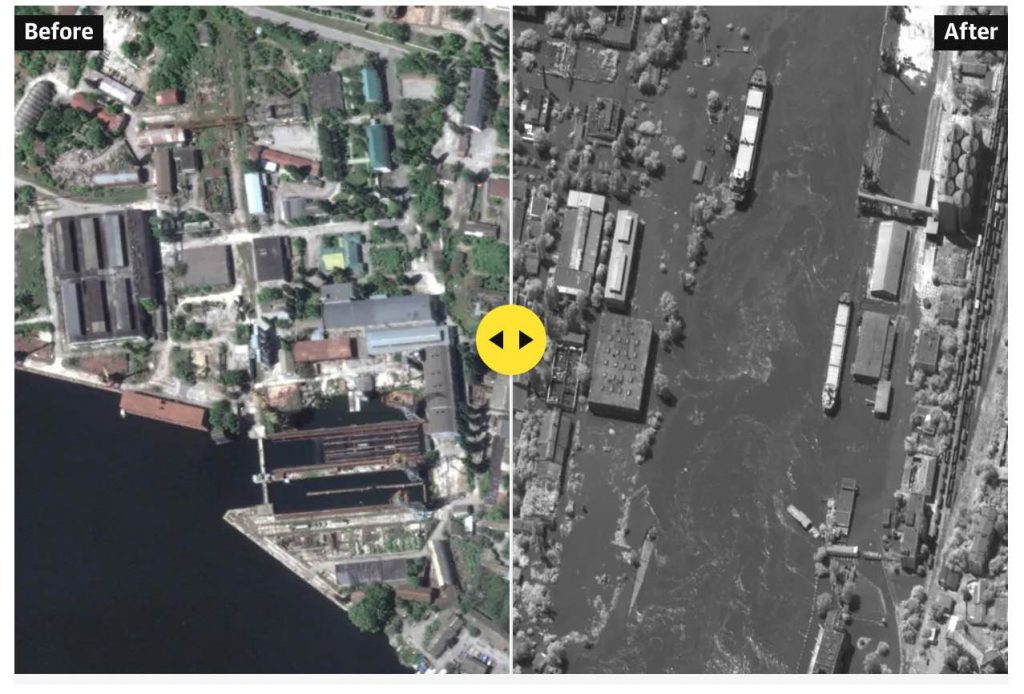
The list of affected villages it's long:Tyaginka, Ivanivka, Mykilske Tokarivka, Ponyativka, Bilozerka and many other rural communities along the Dnipro embankment.It is unclear when, or if, the locals will ever be able to return home.
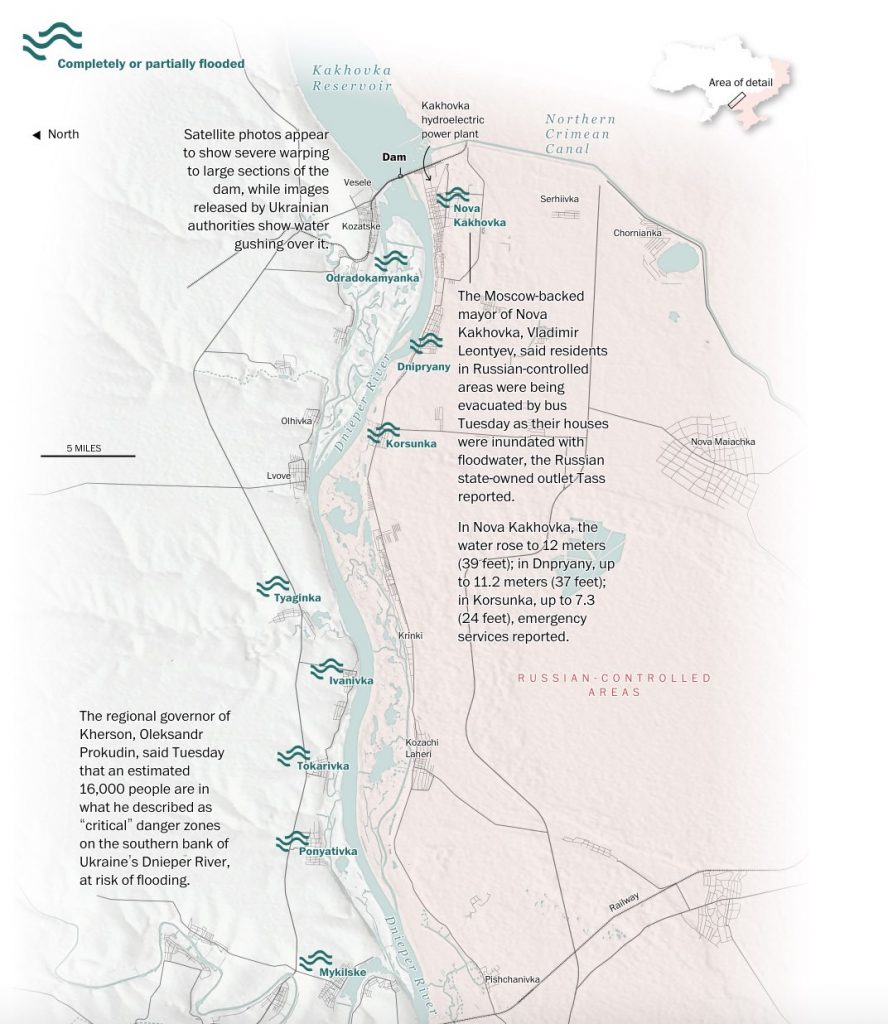
The mayor of Nova Kakhovka, Vladimir Leontyev, appointed from Moscow, said the city was under water and that 900 people had been evacuated.Some images showed swans sliding into the water that transformed the central square in front of the city's white-painted Stalin-era Palace of Culture into a giant lake.The stadium, the river park, the cinema and the zoo with its 300 animals declared drowned were also submerged.
Nova Kakhovka in Kherson region right now:lower city part flooded, zoo, summer cinema, park area, stadiums.Street along the shore was flooded.Old part of city, 2- and and 3-story Finnish houses, including those that belong to architectural monuments, Radio Svoboda reported pic.twitter.com/5ePakh8NDl
— Margo Gontar 🇺🇦 (@MargoGontar) June 6, 2023
In the morning, in a paradoxical video, the governor of the Kherson region, Vladimir Saldo, appointed by Moscow, denied the evidence, stating that life continued normally in Nova Kakhovka:“I just drove the streets.Gas stations work, some shops work, even companies work,” he declared while behind him, through an office window, it was possible to see the water level rising more and more.
Vladimir Saldo, the Russia-installed occupation governor of Kherson region, claims people in Nova Kakhovka are "calmly moving about the streets" after the nearby dam burst and flooded the town.
— max seddon (@maxseddon) June 6, 2023
Calmly...swimming? pic.twitter.com/RZ5Z6zxl42
For the city of Kherson, which has endured eight months of occupation, the flooding was another terrible blow.Water levels rose more than 10 feet throughout the day and by mid-afternoon were still rising 2 to 3 inches every half hour in the lowest parts of the city, according to hydrologist Larysa Musian.The micro-district of Ostiv, a residential area in the middle of the Dnipro, connected to Kherson by several intersections, among the most affected by these months of war, has largely disappeared.The hydropark and the oil terminal were submerged first, followed by private homes, of which only the metal roofs could be glimpsed emerging from the water.Residents were taken away by bus from three collection points;bedridden and disabled people were removed by emergency workers from homes and hospitals.
In total, there are around 16,000 people on the western bank of the Dnipro River in the Ukrainian-controlled Kherson region, according to Oleksandr Prokudin, the region's military administrator.Residents were evacuated by buses and trains.
Rescue teams have reached southern Ukraine from Kyiv:vehicles designed to cross floodwaters, generators, mobile water treatment plants, water trucks and other equipment were sent.Authorities sent 53 evacuation buses to bring people from Nova Kakhovka and two other nearby settlements to safety.In Mykolaiv, an emergency train he left to bring people fleeing rising waters in Kherson to safety.As of 3pm local time, according to the Ukrainian Interior Ministry, 1,300 people had been evacuated from a total of 24 flooded villages.
Rescuers on the right bank of the river took people to safety while trying to dodge gunshots, as some videos released on social media also show.
Video from the Ostrov neighborhood of Kherson.
— Chris York (@ChrisDYork) June 6, 2023
The woman who filmed it claims shelling by Russian forces in the area "has gone on all day."
"Not only are they flooding us, they also kill those who evacuate." pic.twitter.com/fqnVSD82rw
“The biggest difficulty right now is not water.It's the Russians across the river who are attacking us with artillery,” said Andrew Negrych who was coordinating the relief effort for a US charity, Global Empowerment Mission.
The causes
After initially denying that anything had happened to the dam, local pro-Russian authorities blamed the dam's destruction on Ukrainian bombing.Kremlin spokesman Dmitri S.Peskov spoke of "multiple attacks" and "sabotage" action by Ukrainian forces, without however providing any evidence.
Hypothesis rejected by Ukraine.“It is physically impossible to detonate it somehow from the outside, by bombing.It was undermined by the Russian occupiers.And they blew it up,” he declared Zelensky on Twitter.
Natalia Humeniuk, spokeswoman for the Joint Forces Command Southern Ukraine, he said to the news agency UNIAN and others Radio Liberty that “there is no doubt” that the dam was demolished by one or more internal explosions as evidenced by some videos and still images in the public domain that appear to show how the main structure of the dam collapsed from the inside.“Last year, Ukrainian military intelligence reported that the Kakhovka hydroelectric power plant had been mined by Russian troops, publishing photographic and video evidence,” he declared al Kyiv Post Andriy Yusov, spokesman for the military intelligence of the Armed Forces of Ukraine (AFU).According to Ukrainian military intelligence, the 205th Motor Rifle Brigade of Russia was behind the explosion, having installed the explosives inside the dam.A move to slow down Kyiv's counteroffensive east of the Dnipro, in the Donetsk region, to reconquer the territories held by Moscow's forces, which had started to be talked about just a day earlier.
However, it is still unclear what caused the dam to collapse.An analysis of CNN of some satellite images show that the dam was already damaged a few days before suffering structural collapse.Satellite images show that the road bridge spanning the dam was intact on May 28 and suggest that the loss of the bridge section may have occurred between June 1 and 2, leading to failure on June 6.
Over the course of more than a year of heavy fighting, the Kakhovka Dam was repeatedly damaged, with each side accusing the other of bombing it.The Russians captured it last year when they advanced towards the Dnipro, but months later as the Ukrainians pushed Russian forces off the western bank, the river - and the dam - became a part of the front line.The Russians kept the dam.There CNN However, he specified that he was not able to independently verify whether the damage to the road bridge may have been decisive for the collapse of the dam or whether the bridge was destroyed in a deliberate attack.
“The dams fail;it's absolutely possible.But I reflect on this case and I say to myself:'Wow, that looks suspicious'", he declared al New York Times Gregory B.Baecher, an engineering professor at the University of Maryland and a member of the National Academy of Engineering, is an expert on dam failures.
Pro-Russian officials in Kherson put forward another thesis:that structural weaknesses and water pressure caused the tank wall to fail.There is some evidence that could support the idea that the collapse of the dam was the result of an accident, caused by gross Russian negligence, reports The Guardian.Last November, Russian troops blew up part of the road crossing the dam during their general retreat from the northern shore of the Kherson region.The goal was to prevent the Ukrainian army from advancing.Photos showed that the surface was damaged.According to satellite images, part of the road was washed away last week.The waters in the reservoir were so high that they reportedly began flowing over the top of the dam's gates.
Finally, there is another hypothesis that is circulating:namely that the Russians kept few floodgates open, causing the water level in the basin to reach its highest level in the last 30 years.
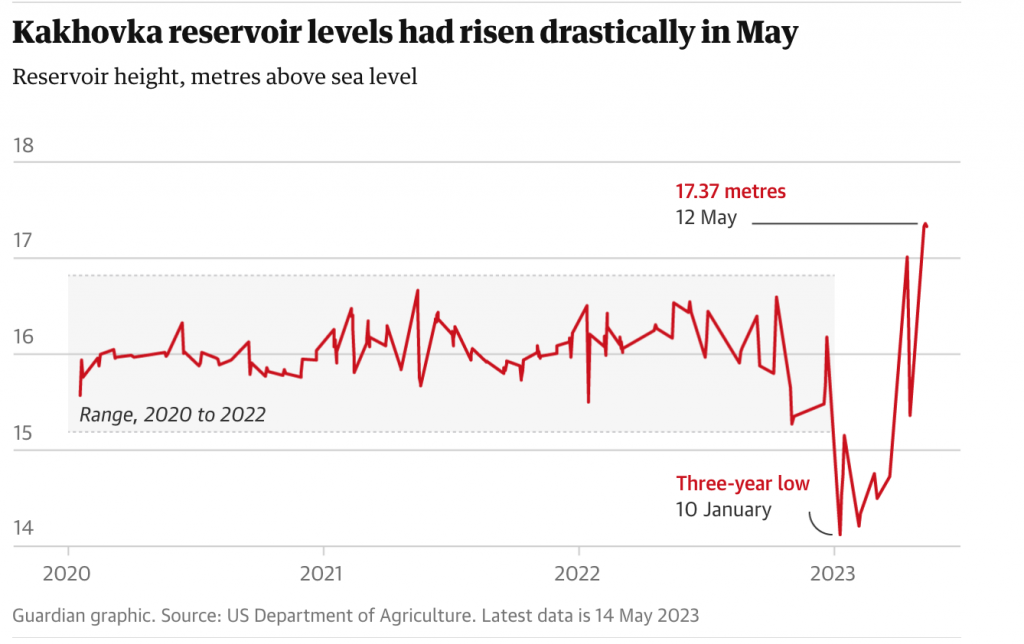
“The Russians allowed the basin to fill to record levels:if the dam failed 'naturally', it certainly did so due to six weeks of overload and stress on the structure", he explained al Guardian David Helms, a former U.S. Air Force and National Oceanic and Atmospheric Administration meteorologist who monitored the dam.
However, adds Professor Baecher, "normally, a failure of this type begins on the earthen side of the dam, on one of the two banks."Instead, in this case, the photos and videos show that the Kakhovka Dam opened from the center.According to the University of Maryland professor, a combination of damaged gates and high water could have torn off some gates, but not to the point of destroying the dam in this way.
The damages
From the potential immediate loss of life to thousands of people forced to abandon their homes and farms, from mines buried in the banks of the Dnipro that could be carried by floods to villages and farmland downstream to ecological impacts, the consequences of the disaster are multiple and could last for generations.It will take weeks before the full consequences of such a massive and sudden shock on the river ecosystem are clear.
Last October, a group of Swedish engineers modeled the potential fallout if Russia used explosives to destroy the dam.According to the model, created by the Damningsverket studio, a wave of water 5 to 6 meters high would hit Kherson within 19 hours.The model predicted that water would flow from the reservoir faster than that from Niagara Falls and warned that riparian cities would be overwhelmed.But, commented Henrik Olander-Hjalmarsson, one of the authors of the study, "it seems that the real scenario is worse than what was envisaged, since the water levels in the reservoir were significantly higher than those in the model".
“There are catastrophic consequences for the environment,” Ukrainian Environment Minister Ruslan Strilets told reporters.Ukrainian officials have warned that at least 150 tons of oil stored at the dam's hydroelectric power plant have leaked into the waterway.
The most immediate impact concerns first and foremost the inhabitants of southern Ukraine who depended on the basin's water for daily needs, as well as for agriculture which is the source of much of the country's important agricultural exports.“Although it is possible that Ukraine can pump water from the ground to compensate for some of the reservoir's losses, it could quickly deplete it,” he declared al Washington Post Doug Weir, director of research and policy at the Conflict and Environment Observatory, a British organization tracking the environmental impacts of the war in Ukraine.
Destructed Kakhovka dam is important for agriculture.This is a map of the main UA irrigation systems (Institute of Water Problems and Land Reclamation of the National Academy of Agrarian Sciences).In total, there were up to 0.5 million ha under irrigation in Ukraine 1/3 pic.twitter.com/RoeLTkViLZ
— Oleg Nivievskyi (@oniviev1) June 6, 2023
"People will not have drinking water or water for cooking.There will be no water to cultivate the fields,” said Anna Ackermann, a member of the board of directors of Ecoaction, one of Ukraine's leading environmental civic organizations.Furthermore, Ackermann adds, pollutants from industries along the banks of the Dnipro River could be transported by the waterway into the Black Sea.
“There is a lot of different debris flowing into the flood, including from all the factories and workshops that produce and use chemicals and other toxic elements,” explains Mohammad Heidarzadeh, assistant professor of architecture and civil engineering at the University of Bath.
And because the Dnipro River has been a front line in the conflict, a flash flood could pose other dangers, experts said, including taking with it landmines that had been placed on its banks and moving them to other unexpected places .
Added to this are fears for the operation of the Zaporizhzhia nuclear power plant.Given the proximity of the plant and considering that the dam provided the water necessary for cooling the reactors, at first there were fears that the dam explosion could trigger a nuclear accident, but the Ukrainian energy operator Energoatom immediately clarified that the situation was under control.Even the International Atomic Energy Agency, the United Nations' nuclear watchdog, he excluded “immediate risks to nuclear safety” and said it was monitoring the situation closely.
“In order to operate safely, the Zaporizhzhia nuclear power plant needs a certain volume of water to carry out essential cooling processes for its units.There is enough water to supply the plant for a long period of time,” he explained al Kyiv Post Victoria Voytsitska, former secretary of the Committee on Fuel, Nuclear Policy and Security of the Ukrainian Parliament.
Finally, there are the consequences on energy security.The destruction of the dam deprives Ukraine of long-term hydroelectric power generation capacity.As stated by the Ukrainian state hydroelectric company, “the Kakhovka power plant can no longer be restored”.
UN climate negotiations begin in Germany without a final agenda
The last round of UN climate negotiations before COP28 has begun in Bonn, Germany, without an agenda for technical discussions having been agreed.Optimism that the 10-day meeting will lead to a clear agenda for the Dubai Climate Conference in December is increasingly tenuous, reports Reuters.“Despite months of discussions since the previous COP27 in Egypt, there has been no agreement on the adoption of the agendas proposed by the permanent subsidiary bodies of the COP,” Nabeel Munir, president of the subsidiary body for COP, said at the opening of the Bonn talks. the implementation (SBI) of the United Nations Framework Convention on Climate Change.
“I believe we are at a turning point.We know that rapid changes often follow a long gestation period.But the gestation period for climate action has been quite long.Let us get ahead of the tipping point,” Simon Stiell, executive secretary of the United Nations Framework Convention on Climate Change, told delegates in attendance.
"The European Union and many developing countries wanted to put the discussion of the 'mitigation work programme', which concerns governments' commitments to reduce greenhouse gas emissions, on the agenda, but China fought to obtain a mandate to prioritize plans to adapt to the impacts of the climate crisis", writes Fiona Harvey on Guardian.Other major sources of contention include the resolution to phase out fossil fuels, the role of renewable energy, the issue of “loss and damage,” which refers to funds to help rescue poor countries most exposed to effects of the climate crisis, and the assessment of how far governments are from respecting the commitments made in Paris in 2015.Stiell did not specifically mention these issues, but urged governments to find common ground.
Satellite observations over the last century and a new climate model predict the North Pole will completely melt every September by 2030
According to one study published on Nature Communications, Even if greenhouse gas emissions are drastically reduced, in the coming decades the Arctic will be ice-free as early as September.However, if emissions slowly decline or continue to increase, the first ice-free summer could be in 2030, a decade earlier than previous projections.Research shows that 90% of the melting is the result of human-caused global warming, while the rest is due to natural factors.
From the beginning of satellite recordings in 1979, summer Arctic ice shrank by 13 percent in a decade.Arctic sea ice reaches its annual minimum in late summer, in September, and in 2021 it reached its second-lowest extent on record.
“Unfortunately, it is now too late to save Arctic summer sea ice,” he declared the Prof.Dirk Notz, of the University of Hamburg, Germany, who was part of the study team.“As scientists, we have been warning about the loss of Arctic summer sea ice for decades.People didn't listen to our warnings."
In the study, the researchers established for the first time how much the increase in greenhouse gases contributed to the melting of the ice compared to natural factors such as variations in the intensity of the sun and emissions from volcanoes.By calibrating models based on this information, the research led to projections of faster melting and an ice-free summer even in the low-emissions scenario.In the intermediate and high-emissions scenarios, the months of August and October will also become ice-free by around 2080.It is not possible to pinpoint a precise year for the first ice-free summer due to the natural variability of the climate system.
The European Parliament has approved a directive requiring companies to assess risks and prevent harm to human rights, the climate and the environment along their supply chains
On June 1st, the European Parliament approved the directive on the behavior of entrepreneurs for the sustainability of companies, the Corporate Sustainability Due Diligence Directive.
Let's talk about #CSDDD 🧵👇
— ECCØ (@eccoclimate) June 6, 2023
Last June 1st, the European Parliament approved the directive on the behavior of entrepreneurs for the sustainability of companies (Corporate Sustainability Due Diligence Directive)
👍 366 in favor
👎 225 against
⚪38 abstentions
[1/5]
According to the text, approved with 366 votes in favour, 225 against and 38 abstentions, the companies will be held to identify and, where necessary, prevent, end or mitigate, the negative impacts that their activities have on human rights and the environment, such as child labor, slavery, labor exploitation, pollution, environmental degradation and the loss of biodiversity.Additionally, they will need to monitor and evaluate the human rights and environmental impacts of their value chain partners, including suppliers, sales, distribution, transportation, storage, waste management and other areas.
The rules will affect EU companies with more than 250 employees and a turnover exceeding 40 million euros, regardless of their sector, and "parent" companies with more than 500 employees and a turnover exceeding 150 million euros.Companies based outside the EU with a turnover exceeding 150 million euros will also be included, if they have generated at least 40 million euros with business within the EU.
“The new Directive, as well as the Corporate Sustainability Reporting Directive (CSRD) or the European Taxonomy, represents a further tool to increase the comparability of non-financial information and to promote a transparent financial market,” explains the Ecco think tank on Twitter.
Now the negotiation process will begin between Parliament, the Commission and the EU Council, to reach an agreement on the final text.It will then be up to the Member States to introduce the new rules into their national legislation
At least 42 dead and thousands displaced due to floods in Haiti
At least 42 people died and thousands they were displaced after a weekend of heavy rain and flooding in Haiti which caused the flooding of more than 13 thousand homes.The greatest damage was in the western areas of the Caribbean country.
“Although this is neither a cyclone nor a tropical storm, considerable damage has been observed in the affected areas,” said Jean-Martin Bauer, acting humanitarian coordinator for Haiti at the United Nations.
This flood is only the latest blow to a country increasingly affected by natural disasters, starting with the magnitude 7 earthquake which in 2010 caused the death of over 200 thousand people and the destruction of a large part of Port-au-Prince.Since then, Haiti has struggled to recover from the earthquake's devastating consequences on the country's economy and infrastructure, while facing other natural disasters.In August 2021, more than 1,900 people were killed by another 7.2 magnitude earthquake, followed by heavy rain from a tropical depression just two days later.
“I am particularly concerned by this situation at a time when the Haitian population is already highly vulnerable,” Bauer added:“The floods have come at a time when the country is facing a serious humanitarian crisis.”
Even before this weekend's rains and floods, nearly half of Haiti's population, about 5.2 million people, were in need of humanitarian assistance, according to the United Nations.

Preview image:Video frames Guardian
